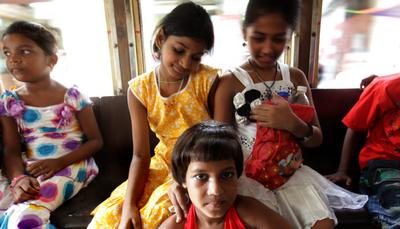— a recent Indian government report estimates that around half a million children have been abducted and forced to work in India’s cities.
It would seem that child trafficking is on the rise. In 2010, almost one in every three missing children was untraced. But in 2013 one in two missing kids was lost forever. India’s National Crime Records Bureau (NCRB) reported 65,038 missing children in the country in 2012. But the official agencies are limited in their ability to estimate the extent of child trafficking, and their estimates fall far short of those by researchers and activists.
India is now a destination, and a place of origin and transit for human trafficking. For two decades there has been a steady rise in the trafficking of children and women from the region due to increasing trans-border mobility. Yet the legal framework for tackling this borderless organised crime is very weak. Social workers also complain that law enforcement authorities often fail to deal with cases seriously.
The rights of trafficked children and women must be more judiciously protected. Victims mostly hail from poor, marginalised communities, and broken families. Even official statistics note that more girls vanish than boys. This is a worrying indication that child traffickers are getting smarter, as girls who are pushed into prostitution or domestic slavery are harder to trace than boys.
India does not have any precise and comprehensive legal structure to handle human trafficking. Trafficking in post-colonial India has mainly been linked to prostitution, but this ignores its complexity and changing character.
The official statistics on prostitution-related trafficking even show a declining trend. The total number of cases under the Immoral Traffic (Prevention) Act, 1956 decreased from 11,242 in 2002 to only 2,563 in 2012, possibly because labour trafficking to domestic and commercial sectors is now easier than sex trafficking.
But for the same period NCRB data shows an increase in instances of child trafficking for the crimes of ‘procuration of minor girls’, ‘importation of girls from foreign country’, ‘selling of girls for prostitution’ and ‘buying of girls for prostitution’. Cases under these crimes collectively increased from 214 to 991.
Clearly, care is needed when explaining and solving trafficking in the age of globalisation.
But there is little effort on the part of the official agencies to link up child trafficking with cases of abduction, forced labour, child labour and child marriage. 18,266 children were abducted in 2012. Yet the justice system fails to punish most offenders. The average conviction rate for these crimes was just 11 per cent in 2012. Anti-trafficking laws focus on sexual exploitation and have ignored more recent reasons for child trafficking. These include domestic, commercial, industrial or bonded labour; tourism; and other forms of exploitation, such as organ sale, adoption, begging, criminal activity or camel jockeying.
Despite legal prohibition, India continues to have 12.66 million child labourers. Cases of labour migration in post-liberalised India are also linked to child trafficking. Child marriage is also considered to be a major modus operandi of child trafficking and there has hardly been any respite from this rampant social evil even after the passing of the Prohibition of Child Marriage Act, 2006. Clearly, any attempt to measure the extent of child trafficking in India would be baffling as the figure would be close to one million a year.
Is this not an epidemic? Wake up India — it’s time to think seriously!
Child trafficking is not merely a socio-legal issue; it is a symptom of much deeper issues in Indian society. As these issues are multi-dimensional, their solutions also lie in a multi-dimensional approach. As human transportation takes place often with the victim’s and their family’s tacit knowledge, detecting a victim and the agents involved — and the task of prevention — is very challenging. Hence, a comprehensive strategy needs to be drawn up to fight the crime. This strategy should include steps such as employment and capacity development, education and empowerment, administrative and community actions, and cooperation among stakeholders to make human rights accessible to the victims.
This problem has many stakeholders, across government, business and society, and all have an important role to play in minimising the vulnerabilities of children and women.
Dr Biswajit Ghosh is a Professor of Sociology at the University of Burdwan, West Bengal, India.

